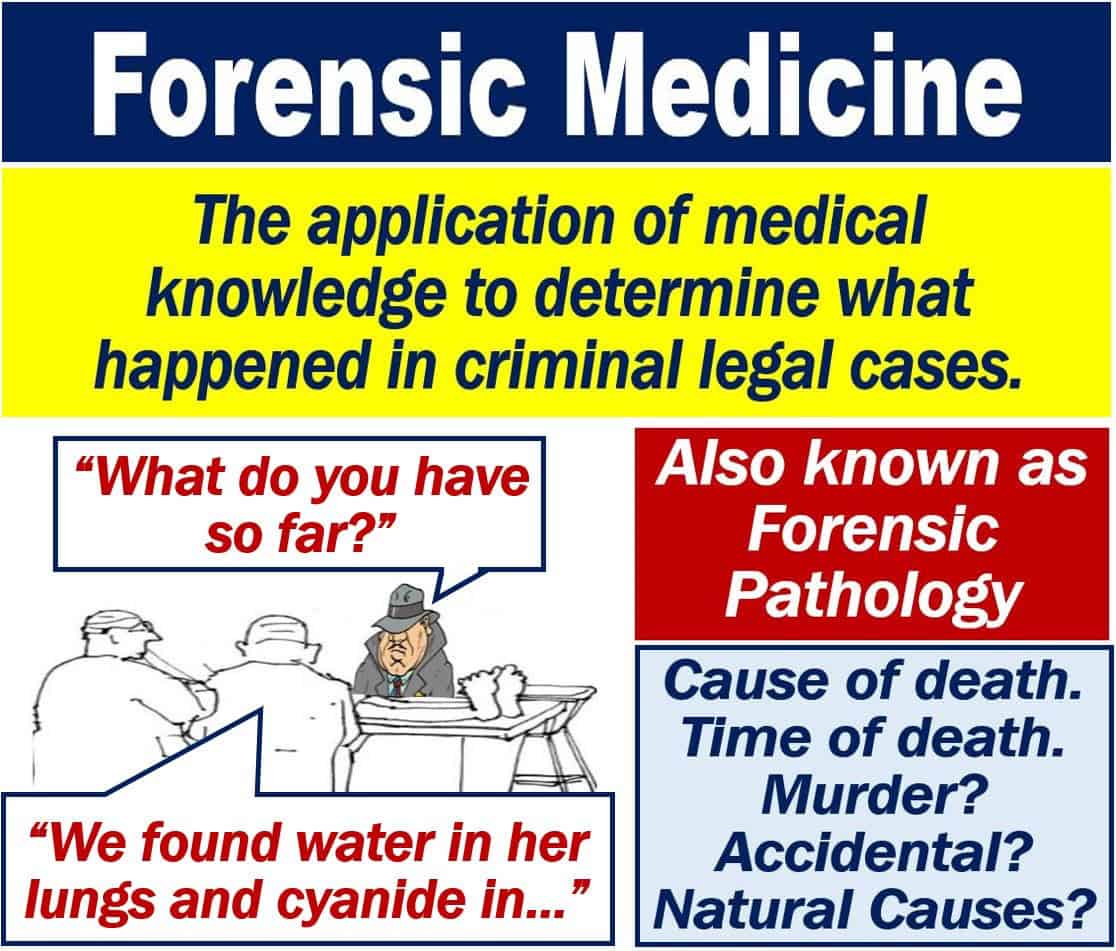Forensic medicine focuses on determining why somebody died. We also call it forensic pathology. It is the application of medical knowledge to a criminal investigation, particularly in establishing time and cause of death. Forensic medicine is also the application of medical knowledge to determine the causes of injury.
Forensic pathology is a subdivision of forensic science and a branch of medicine.
The term ‘forensic,’ in this context, refers to the application of scientific or technical knowledge to solving legal problems. Solving a crime, for example, is a legal problem.
MedicineNet.com has the following definition of the term:
“The branch of medicine dealing with the application of medical knowledge to establish facts in civil or criminal legal cases, such as an investigation into the cause and time of a suspicious death.”
In most countries, forensic medicine or forensic pathology is a subspecialty of anatomical pathology.

Forensic medicine – duties
Forensic medicine is the application of medical jurisprudence. Jurisprudence is the philosophy of law, i.e., the science of law. ‘Legal theory’ means ‘jurisprudence.’
A specialist in forensic medicine is a forensic pathologist, i.e., a doctor who has completed anatomical pathology training.
Forensic pathologists perform, for example, postmortem examinations, i.e., autopsies. The most common reason for performing an autopsy is to determine the cause of death.
Autopsies are also useful for finding out who the dead person is, and also the collection of trace evidence. Forensic pathologists can often tell us, for example, what a dead person’s last meal was.
Regarding the duties of a forensic pathologist, Wikipedia writes:
“The forensic pathology examines and documents wounds and injuries, both at autopsy and occasionally in a clinical setting.”
Forensic medicine – brief history
Ancient Egypt
Forensic pathology has been around for several thousand years. According to an online Sumy State University article, in Ancient Egypt, the authorities required post-mortem examinations in certain deaths. They also required judicial inquiries in certain deaths.
According to some historians, the first medicolegal expert was Imhotep (2650-2600 BC). Imhotep was chief justice as well as the personal physician to Pharaoh Zoser.
Egyptian physicians see Imhotep as the founder of Egyptian medicine. He was the author of a medical treatise which contained anatomical observations, illnesses, as well as cures. The treatise was also unusual because it had no reference to magic.
Ancient Greece
Hippocrates (460-377 BC), ‘the father of Western medicine,’ wrote a collection of treatises. At the time, autopsies were illegal because people regarded the dead human body as sacred.
However, Hippocrates carefully described the human body in many of his works.
Medical historians believe that Herophilus of Chalcedon (335-280 BC) was the first doctor to do regular autopsies. Chalcedon was a Greek physician who spent most of his professional life in Alexandria. Medical historians refer to him as the first anatomist.
Medieval Europe
Doctor Bartolomeo da Varignana, an Italian doctor who performed several autopsies, published his findings in 1247.
His work paved the way for autopsies based on scientific observations. He examined the corpses of people who had died under suspicious circumstances and tried to determine what killed them.
According to an online BBC article:
“His observations were limited by the power of the human eye and his tools.”
Andreas Vesalius (1514 – 1564), a Flemish physician and anatomist, wrote influential books on human anatomy. Many people refer to him as the founder of modern human anatomy.
In 1543, Vesalius printed several descriptions and illustrations of human dissections.
Since the 18th century
In the 18th century, there were regular lectures on forensic medicine in Freiburg, Germany. Vienna was the venue of several lectures in 1804.
Scientists like Carl Liman and Auguste Ambroise Tardieu tried to develop forensic medicine into a science based on empirics.
In 1959, the American Board of Pathology recognized forensic medicine. It wasn’t recognized in Canada until 2003.
Types of forensic specialists
There are dozens of different types of forensic specialists, including art forensics, forensic botany, and digital forensics.
There is also forensic anthropology, forensic archaeology, and forensic astronomy.
Forensic accountants, for example, are the detectives of the financial world. Forensic engineers, on the other hand, try to determine what went wrong with a machine, structure, material, or component.
All the different forensics are subdivisions of forensic science.
